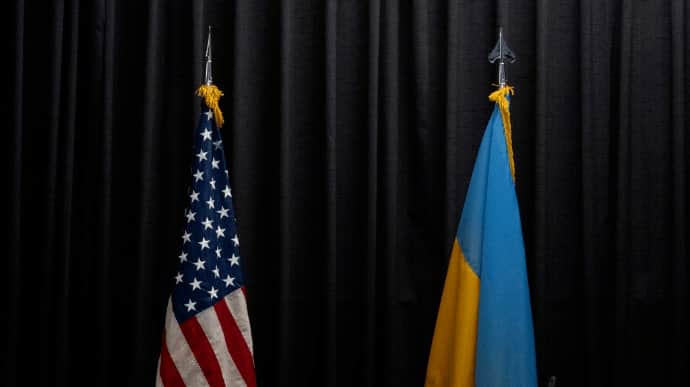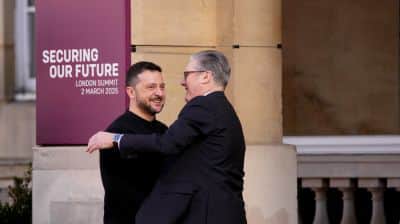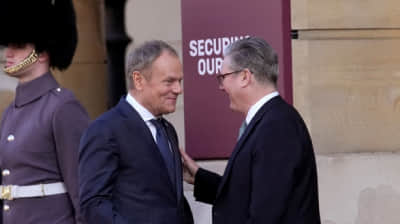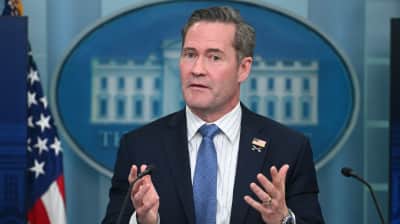CIA works closely with Ukraine and has invested tens of millions of dollars – WP

Since 2015, the American CIA has spent tens of millions of dollars on building up Ukraine's intelligence services. The two work closely together, but the CIA is currently trying to distance itself from some of Kyiv's lethal operations.
Source: The Washington Post, based on interviews with more than two dozen current and former Ukrainian, US and European intelligence and security officials
Quote: "The missions have involved elite teams of Ukrainian operatives drawn from directorates that were formed, trained and equipped in close partnership with the CIA, according to current and former Ukrainian and U.S. officials.
Since 2015, the CIA has spent tens of millions of dollars to transform Ukraine’s Soviet-formed services into potent allies against Moscow, officials said.
The agency has provided Ukraine with advanced surveillance systems, trained recruits at sites in Ukraine as well as the United States, built new headquarters for departments in Ukraine’s military intelligence agency, and shared intelligence on a scale that would have been unimaginable before Russia illegally annexed Crimea and fomented a separatist war in eastern Ukraine. The CIA maintains a significant presence in Kyiv, officials said."
Details: US intelligence officials have stated that the CIA was not involved in targeted killing operations conducted by Ukrainian security services and that the agency's work was focused on enhancing the ability of Ukrainian services to gather intelligence on a dangerous adersary.
A senior intelligence official stated that "any potential operational concerns have been conveyed clearly to the Ukrainian services."
Quote: "Many of Ukraine’s clandestine operations have had clear military objectives and contributed to the country’s defense. The car bombing that killed Daria Dugina, however, underscored Ukraine’s embrace of what officials in Kyiv refer to as ‘liquidations’ as a weapon of war.
…Ukraine’s affinity for lethal operations has complicated its collaboration with the CIA, raising concerns about agency complicity and creating unease among some officials in Kyiv and Washington.
Even those who see such lethal missions as defensible in wartime question the utility of certain strikes and decisions that led to the targeting of civilians including Dugina or her father, Alexander Dugin — who officials acknowledge was the intended mark — rather than Russians more directly linked to the war."
More details: A senior Ukrainian official told the WP that Ukraine has "too many enemies who are more important to neutralise. People who launch missiles. People who committed atrocities in Bucha. Killing the daughter of a pro-war firebrand is ‘very cynical’."
Others expressed broader concerns about Ukraine's ruthless tactics, which may seem justified now, especially against a country accused of large-scale war atrocities, but may prove difficult to rein in later.
A former senior CIA official, commenting on the work of Ukraine's intelligence services, said that "we are seeing the birth of a set of intelligence services that are like Mossad in the 1970s," meaning the Israeli spy service accused of assassinations in other countries.
Quote: "The pressure on Kyiv to score victories against Russia and find ways to deter further aggression create incentives to exaggerate the record and capabilities of Ukraine’s services."
More details: "All targets hit by the SBU [Security Service of Ukraine] are completely legal," Vasyl Maliuk, head of the service, said in a statement to the Washington Post. The statement did not mention targeted killings, but Maliuk said that Ukraine "does everything to ensure that fair punishment will ‘catch up’ with all traitors, war criminals and collaborators".
Current and former US and Ukrainian officials said that both sides try to maintain a distance between the CIA and the lethal operations conducted by its partners in Kyiv. After some operations, CIA officials expressed concern but did not stop providing support.
"We never involved our international partners in covert operations, especially behind the front lines," a former senior Ukrainian security official said.
Officers of the Security Service of Ukraine (SSU) and Defence Intelligence of Ukraine were not accompanied by their CIA counterparts. Ukraine avoided the use of weapons or equipment that could be linked to US sources, and even covert funding flows were segregated.
"We had a lot of restrictions about working with the Ukrainians operationally," said a former US intelligence official. "The emphasis was more on secure communications and tradecraft, and pursuing new streams of intelligence inside Russia rather than ‘here’s how you blow up a mayor.’ I never got the sense that we were that involved in designing their ops."
Despite this, officials acknowledged that the lines were sometimes blurred. CIA officers in Kyiv were briefed on some of Ukraine's most ambitious plans for strikes. In some cases, including the attack on the Crimean Bridge, US officials expressed concern.
Ukrainian security officers developed their own policy on which operations to discuss with the US and which to keep secret.
"There were some things that maybe we wouldn’t talk about with CIA counterparts," another Ukrainian security officer, involved in such missions, said. He added that "crossing those boundaries would lead to a terse reply from Americans: ‘We don’t want any part of that’."
The CIA's deep partnership with Ukraine, which has persisted even as the country has been embroiled in the impeachment scandal of President Donald Trump, represents a dramatic turnaround for agencies that have been on opposite sides of the Cold War for decades.
Partly because of this legacy, just last year the CIA removed Ukraine from its "non-fraternization" list of countries, which are considered to pose a security threat such that contact with their citizens is prohibited without prior authorisation.
Cooperation between the CIA and Ukraine began after the 2014 protests.
Initially, cooperation was limited, due to concerns on both sides that the Ukrainian services were still largely infiltrated by the Russian FSB, the Russian agency that is the main successor to the Soviet KGB.
According to officials, the CIA and the Security Service of Ukraine have created a completely new directorate to manage these risks, focusing on so-called "active measures" against Russia, which is isolated from other units of the SSU.
The new unit has received a prosaic title, the Fifth Directorate, so that it could be distinguished from the other four SSU units. Later, a sixth directorate was created, which cooperated with UK intelligence services, officials said.
Training areas were located outside of the city of Kyiv, where selected recruits underwent training under the guidance of CIA personnel.
The plan was to form units "capable of operating behind front lines and working as covert groups," said a Ukrainian official who participated in the programme.
The CIA has provided secure means of communication, including eavesdropping equipment which allowed Ukraine to intercept Russian telephone calls and emails, and even supplied the disguises and separatist uniforms to make it easier for the operatives to infiltrate occupied Ukrainian cities.
The first missions focused on recruiting informers among the puppet officials of Russia in the occupied territories as well as on cyber and electronic interception. The SSU also started carrying out sabotage operations and missions to capture separatist leaders and Ukrainian collaborationists, some of whom were taken to secret places of detention.
But soon the operations became lethal. In three years, at least half a dozen of Russian operatives, top ranking separatist commanders and collaborators were killed as a result of such attacks, which were frequently explained as the result of internal squabbles but in reality were carried out by the SSU.
Yevgeny Zhilin, leader of a pro-Russia group of militants in the east of Ukraine who was shot in 2016 in a Moscow restaurant, was among these fatalities. A year later, a separatist commander known as Givi was killed in the occupied city of Donetsk in the course of an operation during which a woman accusing him of rape was recruited to plant a bomb, as stated by an official involved in this mission.
Ukrainian officials reported that Ukraine’s shift to more deadly methods was caused by Russia’s aggression and atrocities.
Besides helping to develop the new SSU department, the CIA was also working on a more ambitious project with Ukrainian military intelligence.
Ukraine’s Defence Intelligence (GUR), with fewer than 5,000 employees, was half the size of the SSU and had a narrower focus on spying and active operations against Russia. In addition, young employees with less Soviet experience worked there while the SSU was still considered as an organisation largely influenced by Russian intelligence.
"We calculated that GUR was a smaller and more nimble organisation [than the SSU – ed.] where we could have more impact," said a former US intelligence official who worked in Ukraine. "GUR was our little baby. We gave them all new equipment and training." GUR officers "were young guys not Soviet-era KGB generals," the official said, "while the [SSU] was too big to reform."
In 2015, the CIA started such a massive transformation of GUR that in a few years "we had kind of rebuilt it from scratch," said a former member of US intelligence, who used to be one of the main architects of the effort and the CIA station chief in Kyiv. Now they are in charge of a task force on Ukraine at CIA headquarters.
Ukraine’s Defence Intelligence started recruiting operatives for its new active measures department. Its operatives developed their skills at training facilities in Ukraine and later in the US, from covert manoeuvres behind the adversary’s lines to managing platforms for arms and explosives storage. American officials had stated that the training was carried out with the goal of helping Ukrainian operatives protect themselves in dangerous environments controlled by Russia, not to cause harm to Russian targets.
Some of GUR’s latest recruits transferred from the SSU, enticed by an opportunity to work in a competing service which had acquired new power and resources.
Among them is Vasyl Burba, who managed the operations of the SSU Fifth Directorate before transferring to the GUR and serving as the head of the institution from 2016 to 2020. Burba became so close to the CIA, which made him Moscow’s target, that when he was fired from his office after Volodymyr Zelenskyy was elected president, the agency gave him an armoured vehicle. Asked for a comment for the WP’s article, Burba refused.
The CIA helped GUR buy the most advanced surveillance and electronic interception systems, including mobile equipment which could be installed along Russian-controlled lines in the east of Ukraine, as well as software used to intercept cell phones of the Kremlin officials who visited the occupied territories. Ukrainian officers were operating on Ukrainian systems, but everything they found out was shared with American services.
Worried that Ukrainian intelligence’s obsolete equipment was likely tampered with by Russian intelligence, the CIA paid for new headquarters for the "spetsnaz" paramilitary division of GUR, and the separate directorate responsible for electronic espionage.
Officials said the new capabilities were "transformative".
"In one day we could intercept 250,000 to 300,000 separate communications from Russian military and FSB units," said a former senior GUR official. "There was so much information that we couldn’t manage it ourselves."
Officials said the data sets were transferred through a new СIA-built facility to Washington, where they were scrutinised by CIA and National Security Agency (NSA) analysts.
"We were giving them the ability — through us — to collect on Russian targets," said a former GUR official. Answering a question about the level of CIA investment, the official said: "It was millions of dollars".
As time passed, GUR also developed a network of sources within Russia's security apparatus, including the FSB unit responsible for operations in Ukraine. Indicative of the trust between the US and Ukraine, officials say, is that the CIA was allowed to have direct contact with agents recruited and managed by Ukrainian intelligence.
The resulting intelligence has mostly been kept out of the public domain, with few exceptions. The SSU began releasing compromising or embarrassing intercepts of conversations, including one involving Russian commanders discussing their country's culpability in the downing of a Malaysia Airlines passenger jet in 2014.
Nevertheless, officials noted that the intelligence gained through US-Ukraine cooperation has its limits. For example, the Biden administration's warnings about Russian President Vladimir Putin's determination to overthrow the Kyiv government were based primarily on separate intelligence streams to which Ukraine was not initially privy.
To some extent, officials admit, Ukraine's own intelligence-gathering efforts fuelled Zelenskyy's and others' scepticism of Putin's plans, as they eavesdropped on military and FSB units that had not been informed of these intentions until the full-scale war began.
"They were getting an accurate picture from people who were also in the dark," a US official said.
The newspaper's sources indicate that both of the CIA-funded GUR structures were among dozens of crucial facilities targeted by Russian strikes in the early days of the war. These facilities are still in operation.
The new capabilities of Ukrainian intelligence proved valuable from the very beginning of the full-scale war. To illustrate, the SSU acquired intelligence on major Russian targets, leading to strikes that killed several commanders and nearly claimed the life of Valery Gerasimov, Chief of Russia's General Staff.
Throughout the past year, missions by the special services have increasingly focused on targets not only behind Russian lines but also inside that country.
The SSU has struck the Crimean Bridge twice in the past year, including with the explosion that killed five people and created a hole in the westbound lanes in October 2022.
Zelenskyy initially denied Ukraine's involvement. However, Vasyl Maliuk, the SSU chief, described the operation in great detail in an interview earlier this year, admitting that his service had placed high-powered explosives in a truck carrying industrial-size rolls of cellophane.
Like other SSU operations, the operation involved unwitting accomplices, including a truck driver killed in the explosion. US officials, notified in advance, expressed concern about the attack, fearing an escalation by Russia.
These concerns were likely to have been allayed when the SSU struck the bridge a second time nine months later, using surface drones developed in a top-secret operation involving the CIA and other Western intelligence agencies.
Maliuk's public description of the operation goes against typical intelligence practices, but it helped Kyiv claim success and reflects SSU’s growing rivalry with the GUR. Kyrylo Budanov, Chief of Ukraine's Defence Intelligence, has a habit of boasting about his agency's achievements and taunting Moscow.
The two services overlap to some extent, although officials say the SSU tends to carry out more complex missions with longer lead times, while the GUR tends to work at a faster pace. Ukrainian officials have denied that either agency was directly involved in the September 2022 attack on the Nord Stream 2 pipeline in the Baltic Sea, although the US and other Western intelligence agencies have concluded that Ukraine was involved in this.
The GUR has used its own fleet of drones to carry out dozens of attacks on the Russia Federation, including strikes that breached Russian air defences and hit buildings in Moscow. These included an operation in May 2023 that briefly set fire to part of the Kremlin's roof.
The strikes involved both long-range drones launched from Ukraine and teams of operatives and partisans working inside Russia, officials said. An official involved in the deals said the engines for some of the drones had been purchased from Chinese suppliers with private funding that could not be linked to Ukrainian sources.
Security officials said no major SSU or GUR operation takes place without permission – tacit or otherwise – from Zelenskyy. Zelenskyy's spokesman did not respond to requests for comment.
However, sceptics are concerned that Ukraine's practice of targeted assassinations and drone strikes on Moscow skyscrapers is not helping its fight against Russia or its long-term aspirations to join NATO and the EU.
A senior Ukrainian official who has worked closely with Western governments to coordinate support for Ukraine said attacks on non-combatants and the bombing of Moscow buildings feed Putin's false narrative that Ukraine poses a growing danger to ordinary Russians.
"It plays into his lies that Ukrainians are coming for them," the official said.
WP has noted that the car bombing that killed Dugina last year continues to stand as "one of the more extreme cases of lethal revenge". Ukrainian operatives installed a secret compartment in the car's cat crate and used it to hide bomb components, said security officials familiar with the operation.
Support UP or become our patron!





